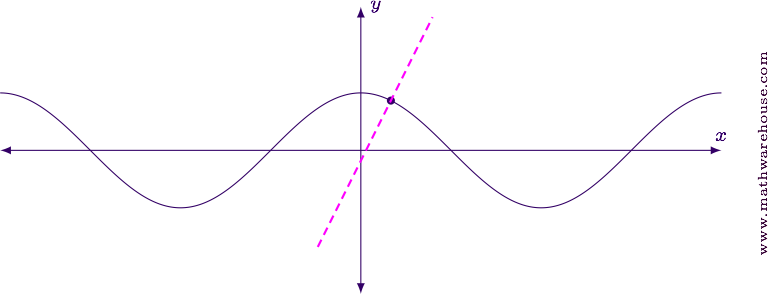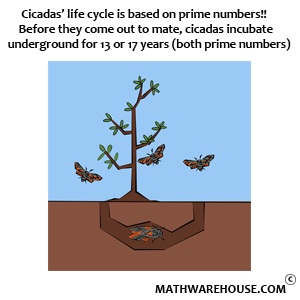Quick Overview
- To find the equation of a line you need a point and a slope.
- The slope of the tangent line is the value of the derivative at the point of tangency.
- The normal line is a line that is perpendicular to the tangent line and passes through the point of tangency.
Examples
Example 1
Suppose $$f(x) = x^3$$. Find the equation of the tangent line at the point where $$x = 2$$.
Step 1Find the point of tangency.
Since $$x=2$$, we evaluate $$f(2)$$.
$$ f(2) = 2^3 = 8 $$
The point is $$(2,8)$$.
Step 2Find the value of the derivative at $$x = 2$$.
$$ f'(x) = 3x^2\longrightarrow f'(2) = 3(2^2) = 12 $$
The the slope of the tangent line is $$m = 12$$.
Step 3Find the point-slope form of the line with slope $$m = 12$$ through the point $$(2,8)$$.
$$ \begin{align*} y - y_1 & = m(x-x_1)\\[6pt] y - 8 & = 12(x-2) \end{align*} $$
Answer$$y - 8 = 12(x-2)$$
For reference, here is the graph of the function and the tangent line we just found.
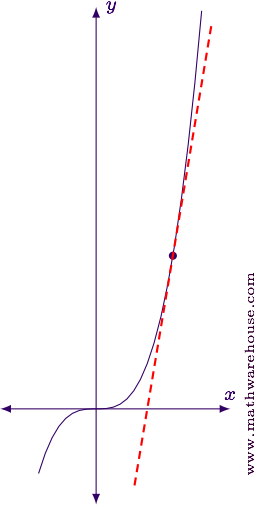
Example 2
Suppose $$f(x) = x^2 - x$$. Find the equation of the tangent line with slope $$m = -3$$.
Step 1Find the derivative.
$$ f'(x) = 2x -1 $$
Step 2Find the $$x$$-value where $$f'(x)$$ equals the slope.
$$ \begin{align*} f'(x) & = 2x -1\\[6pt] -3 & = 2x -1\\[6pt] -2 & = 2x\\[6pt] x & = -1 \end{align*} $$
Step 3Find the point on the function where $$x = -1$$.
$$ f(-1) = (-1)^2 - (-1) = 1 + 1 = 2 $$
The point is $$(-1, 2)$$.
Step 4Find the equation of the line through the point $$(-1,2)$$ with slope $$m=-3$$.
$$ \begin{align*} y -y_1 & = m(x-x_1)\\[6pt] y - 2 & = -3(x - (-1))\\[6pt] y - 2 & = -3(x+1) \end{align*} $$
Answer$$ y - 2 = -3(x+1) $$
For reference, here's the graph of the function and the tangent line we just found.
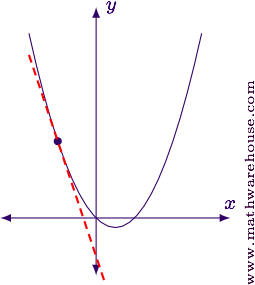
Tangent Lines to Implicit Curves
The procedure doesn't change when working with implicitly defined curves.
Example 3
Suppose $$x^2 + y^2 = 16$$. Find the equation of the tangent line at $$x = 2$$ for $$y>0$$.
Step 1Find the $$y$$-value of the point of tangency.
$$ \begin{align*} \blue{x^2} + y^2 & = 16\\[6pt] \blue{2^2} + y^2 & = 16\\[6pt] \blue{4} + y^2 & = 16\\[6pt] y^2 & = 12\\[6pt] y & = \pm\sqrt{12}\\[6pt] y & = \pm\sqrt{4\cdot 3}\\[6pt] y & = \pm2\sqrt 3 \end{align*} $$
Since the problem states we are interested in $$y>0$$, we use $$y = 2\sqrt 3$$.
The point of tangency is $$(2, 2\sqrt 3)$$.
Step 2Find the equation for $$\frac{dy}{dx}$$.
Since the equation is implicitly defined, we use implicit differentiation.
$$ \begin{align*} 2x + 2y\,\frac{dy}{dx} & = 0\\[6pt] 2y\,\frac{dy}{dx} & = -2x\\[6pt] \frac{dy}{dx} & = -\frac{2x}{2y}\\[6pt] \frac{dy}{dx} & = -\frac x y \end{align*} $$
Step 3Find the slope of the tangent line at the point of tangency.
At the point $$(2,2\sqrt 3)$$, the slope of the tangent line is
$$ \begin{align*} \frac{dy}{dx}\bigg|_{(\blue{2},\red{2\sqrt 3})} & = -\frac {\blue 2} {\red{2\sqrt 3}}\\[6pt] & = -\frac 1 {\sqrt 3}\\[6pt] & = -\frac 1 {\sqrt 3}\cdot \blue{\frac{\sqrt 3}{\sqrt 3}}\\[6pt] & = -\frac{\sqrt 3} 3 \end{align*} $$
The slope of the tangent line is $$m = -\frac{\sqrt 3} 3$$.
Step 4Find the equation of the tangent line through $$(2,2\sqrt 3)$$ with a slope of $$m=-\frac{\sqrt 3} 3$$.
At the point $$(2,2\sqrt 3)$$, the slope of the tangent line is
$$ \begin{align*} y - y_1 & = m(x-x_1)\\[6pt] y - 2\sqrt 3 & = -\frac{\sqrt 3} 3(x-2) \end{align*} $$
AnswerThe equation of the tangent line is $$y - 2\sqrt 3 = -\frac{\sqrt 3} 3(x-2)$$
For reference, the graph of the curve and the tangent line we found is shown below.
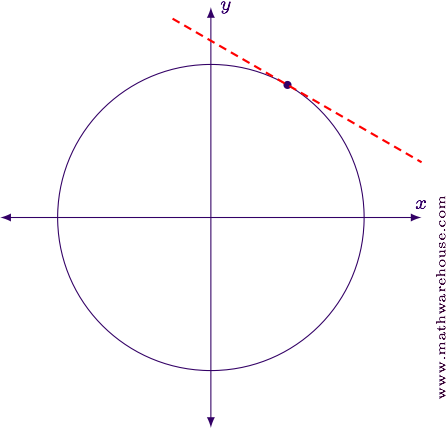
Normal Lines
Suppose we have a a tangent line to a function. The function and the tangent line intersect at the point of tangency. The line through that same point that is perpendicular to the tangent line is called a normal line.
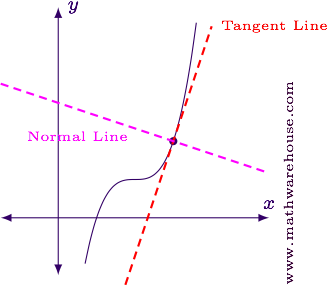
Recall that when two lines are perpendicular, their slopes are negative reciprocals. Since the slope of the tangent line is $$m = f'(x)$$, the slope of the normal line is $$m = -\frac 1 {f'(x)}$$.
Example 4
Suppose $$f(x) = \cos x$$. Find the equation of the line that is normal to the function at $$x = \frac \pi 6$$.
Step 1Find the point on the function.
$$ f\left(\frac \pi 6\right) = \cos \frac \pi 6 = \frac{\sqrt 3} 2 $$
The point is $$\left(\frac \pi 6, \frac{\sqrt 3} 2\right)$$.
Step 2Find the value of the derivative at $$x = \frac \pi 6$$.
$$ f'(x) = -\sin x\longrightarrow f'\left(\frac \pi 6\right) = -\sin\frac\pi 6 = -\frac 1 2 $$
The slope of the tangent line is $$m = -\frac 1 2$$. Since we are looking for the line that is perpendicular to the tangent line, we want to use $$m = 2$$.
Step 3Find the equation of the line through the point $$\left(\frac \pi 6, \frac{\sqrt 3} 2\right)$$ with a slope of $$m =2$$.
$$ \begin{align*} y -y_1 & = m(x-x_1)\\[6pt] y - \frac{\sqrt 3} 2 & = 2\left(x - \frac \pi 6\right) \end{align*} $$
AnswerThe line normal to the function at $$x = \frac \pi 6$$ is $$y - \frac{\sqrt 3} 2 = 2\left(x - \frac \pi 6\right)$$.
For reference, here is the graph of the function and the normal line we found.
